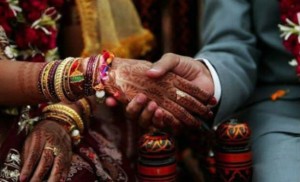(English) Inter-caste nuptials still a taboo


KATHMANDU, Nepal–Laxman Pariyar of Palpa who eloped with a woman from the so-called ‘upper caste’ four years ago could not go back home for fear of revenge from his in-laws. The spouse who has recently managed to stay in the capital Kathmandu is struggling hard to earn their living.
Suman BK of Myagdi district who also tied nuptial knot with a girl from the Brahimin caste (so-called upper caste in social hierarchy) one year ago has also experienced similar fate. BK who has been living in Kathmandu since a year has not been able to go his hometown owing to the warning he faces from his in-laws side. He fled to Kathmandu after he was thrown out from his native village just for marrying a woman from the ‘upper caste’.
Exactly a year ago, two couples were booted out from their village by their families in separate incidents of inter-caste marriage in Panchthar and Tehrathum, in the eastern province of Nepal.
Bhabindra Thulung Rai, 25, and Bhadrika Shankar, 20, of Lumfabung VDC-1 had to vacate their village after Rai’s family threatened to slain him if he stepped inside the house stating that he had married an “untouchable girl”. The couple had got married secretly at a temple in the nearby village in the first week of the June.
A few months ago, a couple at Chittapol VDC-9 of Bhaktapur was expelled from home for inter-caste marriage. The couple of Sagar Pariyar, 20, a boy from the so-called Dalit caste and Sangita Thapa Chhetri, 20, was expelled from the village on August 31.
The aforementioned couples kicked out by their own family members are just the representative character in Nepali society, which often separates them by using force.
Though both the couples are equally responsible for choosing their partners and marrying beyond their caste system, the women were the ones who always got ill-treated and had to face various form of violence in the society.
With an aim to encourage to inter-caste marriage, the government had introduced an allowance of 100 thousand rupees; however the couples like Pariyar are deprived to get that sum due to the administrative hassles.
More and more inter-caste marriage couples are becoming expelled as the government has not imposed the Caste Discrimination and Practice of Untouchability Act, 2011 effectively.
Squeezed between India and China, there are four principle castes in Himalayan Nation: Brahmin, the highest in caste hierarchy followed by Chhetri, the Royal Families caste, then Baise. And finally there is Sudra, the so called lowest caste conventionally known as the “untouchables”.
A study on the status of caste discrimination in the country carried out by the Jagaran Media Centre shows that the rate of refusal of inter-caste weeding stands at 29 per cent.
Nepal is a patriarchal society, where the lowest cast, to the upper casts, is treated like what the black man was to the white man, according to right activist. “Caste base discrimination is the root cause behind the expulsion of marrying couples in the society”, human right activist Sameer Kafle told this portal. According to him it has been already delay to curb the deep rooted discriminatory practice.
